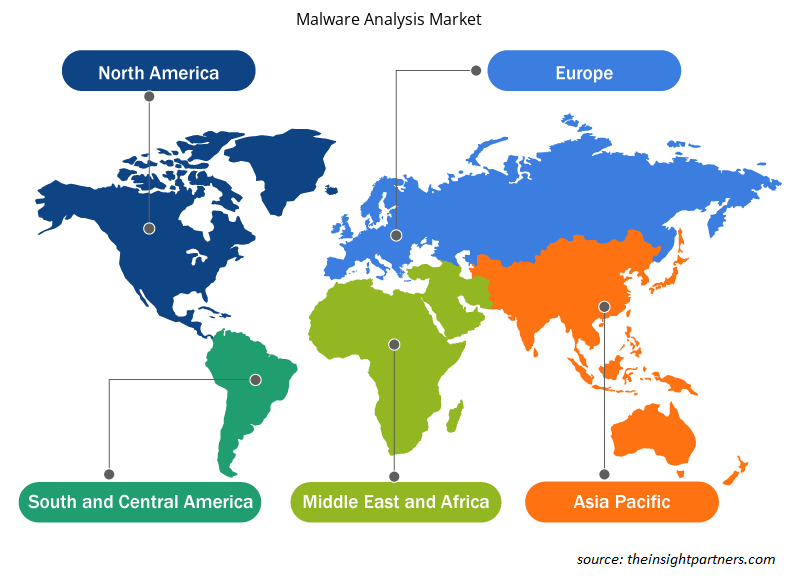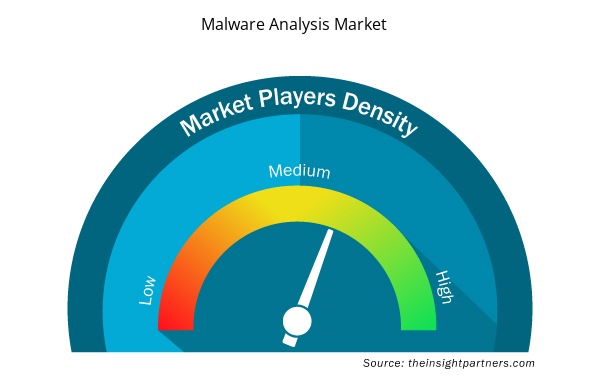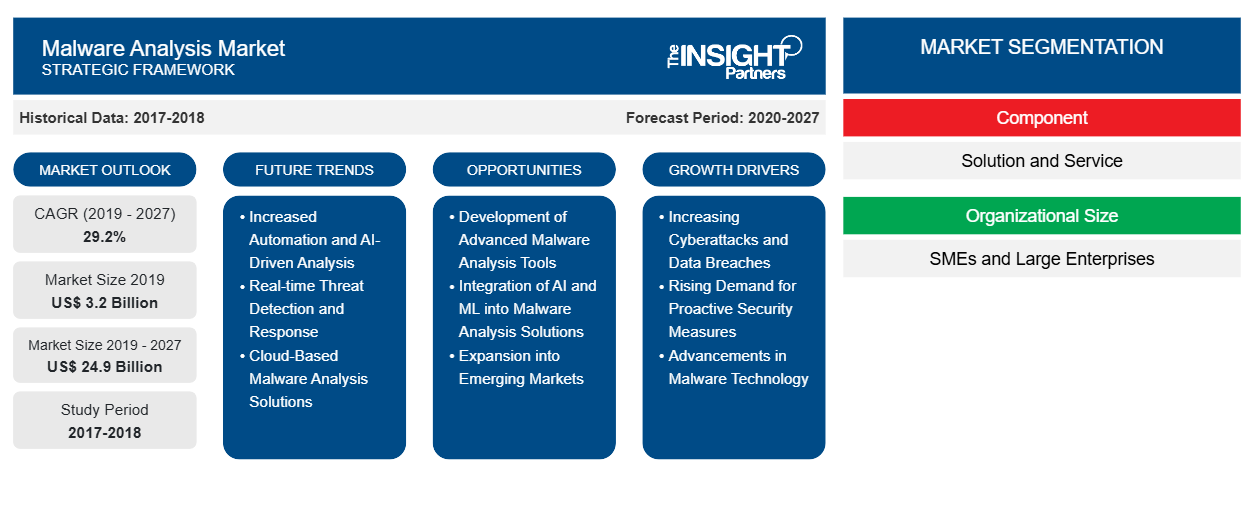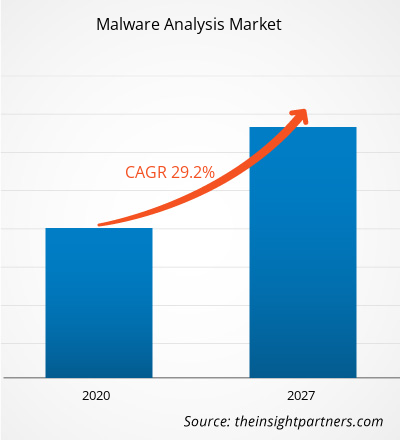[Informe de investigación] Se espera que el mercado de análisis de malware crezca de US$ 3.204,4 millones en 2019 a US$ 24.898,3 millones en 2027; se estima que crecerá a una CAGR del 29,2% entre 2019 y 2027.
El aumento de las iniciativas gubernamentales se debe al crecimiento del mercado. Los gobiernos de varios países del mundo están tomando iniciativas para apoyar la adopción de herramientas de análisis de malware por parte de las empresas. Por ejemplo, en 2017, el gobierno indio lanzó su Cyber Swachhta Kendra, un centro de análisis de malware y limpieza de botnets. El centro tiene como objetivo detectar infecciones de botnets en el país y evitar más infecciones mediante la notificación, la habilitación de la limpieza y la protección de los sistemas de los usuarios finales. Además, en marzo de 2019, el Parlamento Europeo aprobó una nueva “Ley de Ciberseguridad” de la UE. La nueva regulación crea un marco de certificación de ciberseguridad de la UE. Este marco está previsto para aumentar la transparencia de la garantía de ciberseguridad de los productos, servicios y procesos de TIC y, de este modo, mejorar la confianza y ayudar a los usuarios finales a tomar decisiones bien informadas. Otra razón crucial para el marco es evitar el aumento de certificaciones nacionales contradictorias o superpuestas y, de ese modo, reducir los costos. Según el reglamento, la CE está autorizada a adoptar los esquemas europeos de certificación de la ciberseguridad, establecidos por ENISA, en relación con grupos específicos de productos, servicios y procesos de TIC. Los esquemas podrían abarcar, por ejemplo, los productos, servicios y procesos de TIC utilizados en aviones, automóviles, dispositivos médicos, centrales eléctricas y dispositivos de consumo conectados a Internet.
En 2018, la Autoridad Monetaria de Singapur (MAS) lanzó una subvención de 22 millones de dólares para capacidades de ciberseguridad con el fin de ayudar a las instituciones financieras del país a reforzar su resiliencia cibernética y a capacitar a los talentos locales mediante programas de capacitación relacionados con la ciberseguridad, como análisis de malware, operaciones de seguridad, informática forense, vigilancia de ciberamenazas y búsqueda de ciberamenazas. Se espera que estas iniciativas gubernamentales impulsen el crecimiento del mercado de análisis de malware .
Personalice este informe según sus necesidades
Obtendrá personalización en cualquier informe, sin cargo, incluidas partes de este informe o análisis a nivel de país, paquete de datos de Excel, así como también grandes ofertas y descuentos para empresas emergentes y universidades.
- Obtenga las principales tendencias clave del mercado de este informe.Esta muestra GRATUITA incluirá análisis de datos, desde tendencias del mercado hasta estimaciones y pronósticos.
Perspectivas del mercado–
Análisis de mercado de malware
Aumento de la adopción de soluciones digitales por parte de diversos sectores industriales
La implementación de soluciones digitales está ganando ritmo en diversas industrias, entre ellas la fabricación, la atención médica, la automoción, la industria BFSI, los medios de comunicación y el entretenimiento y el comercio minorista, entre otras. Estas industrias se benefician cada vez más de la transformación digital. Los análisis les permiten comprender y atender mejor a los clientes. Además, el acceso a información en tiempo real da como resultado una toma de decisiones eficiente. La automatización de las operaciones comerciales les facilita aumentar la productividad. Por ejemplo, los fabricantes de automóviles han revolucionado su proceso de fabricación con el uso de robots; y las compañías aéreas se han vuelto competentes en la fijación de precios a través de información en tiempo real de la oferta y la demanda. Además, las empresas minoristas con sólidas capacidades digitales han diseñado entornos omnicanal sin fisuras. Asimismo, la industria de la atención médica se ha modernizado a través de registros médicos electrónicos (EHR), herramientas digitales que rastrean los signos vitales de los pacientes, así como consultas virtuales entre pacientes y médicos. Sin embargo, con la creciente adopción de tecnologías digitales como IoT, Big Data e IA, en las empresas y en la sociedad en general, la creciente conectividad de todo ha creado desafíos en términos de cumplimiento, seguridad y protección de datos. Por lo tanto, abordar las nuevas tendencias de malware está impulsando la adopción de herramientas de análisis de malware.
Información basada en componentes
Según los componentes, el mercado de análisis de malware se segmenta en soluciones y servicios. El segmento de soluciones tuvo la mayor participación de mercado en 2018.
Perspectivas basadas en el tamaño de la organización
Según el tamaño de la organización, el mercado de análisis de malware se segmenta en grandes empresas y pequeñas y medianas empresas. El segmento de grandes empresas tuvo la mayor participación de mercado en 2018.
Los actores que operan en el mercado de análisis de malware se centran principalmente en el desarrollo de productos avanzados y eficientes.
- En 2019, Google Cloud y Palo Alto Networks anunciaron nuevas soluciones para ayudar a los clientes a mantenerse seguros. Las dos empresas colaborarán para lanzar nuevas ofertas al mercado y ejecutar varios servicios de Palo Alto Networks en Google Cloud.
- En 2019, Kaspersky anunció su primer Centro de Transparencia en Asia Pacífico en asociación con CyberSecurity Malaysia para que sirva como una instalación confiable para que los socios de la empresa y las partes interesadas gubernamentales vengan a verificar el código fuente de las soluciones de Kaspersky.
Análisis de malware: perspectivas regionales del mercado
Los analistas de Insight Partners explicaron en detalle las tendencias y los factores regionales que influyen en el mercado de análisis de malware durante el período de pronóstico. Esta sección también analiza los segmentos y la geografía del mercado de análisis de malware en América del Norte, Europa, Asia Pacífico, Oriente Medio y África, y América del Sur y Central.

- Obtenga datos regionales específicos para el mercado de análisis de malware
Alcance del informe de mercado de análisis de malware
| Atributo del informe | Detalles |
|---|---|
| Tamaño del mercado en 2019 | US$ 3.2 mil millones |
| Tamaño del mercado en 2027 | US$ 24.9 mil millones |
| CAGR global (2019-2027) | 29,2% |
| Datos históricos | 2017-2018 |
| Período de pronóstico | 2020-2027 |
| Segmentos cubiertos | Por componente
|
| Regiones y países cubiertos | América del norte
|
| Líderes del mercado y perfiles de empresas clave |
|
Densidad de actores del mercado: comprensión de su impacto en la dinámica empresarial
El mercado de análisis de malware está creciendo rápidamente, impulsado por la creciente demanda de los usuarios finales debido a factores como la evolución de las preferencias de los consumidores, los avances tecnológicos y una mayor conciencia de los beneficios del producto. A medida que aumenta la demanda, las empresas amplían sus ofertas, innovan para satisfacer las necesidades de los consumidores y aprovechan las tendencias emergentes, lo que impulsa aún más el crecimiento del mercado.
La densidad de actores del mercado se refiere a la distribución de las empresas o firmas que operan dentro de un mercado o industria en particular. Indica cuántos competidores (actores del mercado) están presentes en un espacio de mercado determinado en relación con su tamaño o valor total de mercado.
Las principales empresas que operan en el mercado de análisis de malware son:
- Compañía: AT&T Inc.
- Laboratorio AO Kaspersky
- Compañía: Broadcom, Inc.
- Sistemas Cisco, Inc.
- CrowdStrike Holdings Inc
Descargo de responsabilidad : Las empresas enumeradas anteriormente no están clasificadas en ningún orden particular.

- Obtenga una descripción general de los principales actores clave del mercado de análisis de malware
El mercado de análisis de malware se ha segmentado de la siguiente manera:
Análisis de malware en el mercado: por componentes
- Solución
- Servicio
Mercado de análisis de malware: por tamaño de organización
- PYMES
- Gran empresa
Mercado de análisis de malware: por implementación
- En las instalaciones
- Basado en la nube
Mercado de análisis de malware: por industria de usuarios finales
- BFSI
- Gobierno
- Cuidado de la salud
- TI y telecomunicaciones
- Fabricación
- Otros
Mercado de análisis de malware por geografía
- América del norte
- A NOSOTROS
- Canadá
- México
- Europa
- Francia
- Alemania
- Italia
- Rusia
- Reino Unido
- Resto de Europa
- Asia Pacífico (APAC)
- Japón
- Porcelana
- Australia
- India
- Corea del Sur
- Resto de APAC
- Oriente Medio y África (MEA)
- Arabia Saudita
- Emiratos Árabes Unidos
- Sudáfrica
- Resto de MEA
- América del Sur (SAM)
- Brasil
- Argentina
- Resto de SAM
Análisis de malware en el mercado: perfiles de empresas
- Laboratorio AO Kaspersky
- AT&T
- Broadcom
- Cisco
- Golpe de masas
- Ojo de fuego
- Fortinet
- Redes de Palo Alto
- Calificaciones
- Microtendencia
- Análisis histórico (2 años), año base, pronóstico (7 años) con CAGR
- Análisis PEST y FODA
- Tamaño del mercado Valor/volumen: global, regional, nacional
- Industria y panorama competitivo
- Conjunto de datos de Excel


- Micro-Surgical Robot Market
- Mice Model Market
- Microcatheters Market
- High Speed Cable Market
- Biopharmaceutical Tubing Market
- UV Curing System Market
- Semiconductor Metrology and Inspection Market
- Health Economics and Outcome Research (HEOR) Services Market
- Microplate Reader Market
- Pharmacovigilance and Drug Safety Software Market

Report Coverage
Revenue forecast, Company Analysis, Industry landscape, Growth factors, and Trends

Segment Covered
This text is related
to segments covered.

Regional Scope
North America, Europe, Asia Pacific, Middle East & Africa, South & Central America

Country Scope
This text is related
to country scope.
Preguntas frecuentes
BFSI dominated the malware analysis market in 2018. BFSI organizations are more vulnerable to cyber-attacks due to huge financial and personal data of customers on systems. In this sector, a massive amount of sensitive data is generated and exchanged daily. With the growing volume of data, end-points are also increasing at a rapid pace and monitoring these end points poses a huge challenge for this sector.
In past few years, cybercrime in the APAC region has grown to be a greater risk as compared to other leading regions. This is majorly because of rapidly increasing connectivity and rushing pace of digital transformation in the region, resulting into sharpening concern for technological threats among the businesses.
Rapid adoption of digitalization among diverse industries, implementation of IoT, and high adoption of connected devices offers lucrative opportunities to the market players. Also, rising trend of BYOD is another significant market opportunity.
Trends and growth analysis reports related to Technology, Media and Telecommunications : READ MORE..
The List of Companies - Malware Analysis Market
- AT&T Inc.
- AO Kaspersky Lab
- Broadcom, Inc.
- Cisco Systems, Inc.
- CrowdStrike Holdings Inc
- FireEye, Inc.
- Fortinet, Inc.
- Palo Alto Networks, Inc.
- Qualys, Inc.
- Trend Micro Incorporated, among others.
The Insight Partners performs research in 4 major stages: Data Collection & Secondary Research, Primary Research, Data Analysis and Data Triangulation & Final Review.
- Data Collection and Secondary Research:
As a market research and consulting firm operating from a decade, we have published and advised several client across the globe. First step for any study will start with an assessment of currently available data and insights from existing reports. Further, historical and current market information is collected from Investor Presentations, Annual Reports, SEC Filings, etc., and other information related to company’s performance and market positioning are gathered from Paid Databases (Factiva, Hoovers, and Reuters) and various other publications available in public domain.
Several associations trade associates, technical forums, institutes, societies and organization are accessed to gain technical as well as market related insights through their publications such as research papers, blogs and press releases related to the studies are referred to get cues about the market. Further, white papers, journals, magazines, and other news articles published in last 3 years are scrutinized and analyzed to understand the current market trends.
- Primary Research:
The primarily interview analysis comprise of data obtained from industry participants interview and answers to survey questions gathered by in-house primary team.
For primary research, interviews are conducted with industry experts/CEOs/Marketing Managers/VPs/Subject Matter Experts from both demand and supply side to get a 360-degree view of the market. The primary team conducts several interviews based on the complexity of the markets to understand the various market trends and dynamics which makes research more credible and precise.
A typical research interview fulfils the following functions:
- Provides first-hand information on the market size, market trends, growth trends, competitive landscape, and outlook
- Validates and strengthens in-house secondary research findings
- Develops the analysis team’s expertise and market understanding
Primary research involves email interactions and telephone interviews for each market, category, segment, and sub-segment across geographies. The participants who typically take part in such a process include, but are not limited to:
- Industry participants: VPs, business development managers, market intelligence managers and national sales managers
- Outside experts: Valuation experts, research analysts and key opinion leaders specializing in the electronics and semiconductor industry.
Below is the breakup of our primary respondents by company, designation, and region:

Once we receive the confirmation from primary research sources or primary respondents, we finalize the base year market estimation and forecast the data as per the macroeconomic and microeconomic factors assessed during data collection.
- Data Analysis:
Once data is validated through both secondary as well as primary respondents, we finalize the market estimations by hypothesis formulation and factor analysis at regional and country level.
- Macro-Economic Factor Analysis:
We analyse macroeconomic indicators such the gross domestic product (GDP), increase in the demand for goods and services across industries, technological advancement, regional economic growth, governmental policies, the influence of COVID-19, PEST analysis, and other aspects. This analysis aids in setting benchmarks for various nations/regions and approximating market splits. Additionally, the general trend of the aforementioned components aid in determining the market's development possibilities.
- Country Level Data:
Various factors that are especially aligned to the country are taken into account to determine the market size for a certain area and country, including the presence of vendors, such as headquarters and offices, the country's GDP, demand patterns, and industry growth. To comprehend the market dynamics for the nation, a number of growth variables, inhibitors, application areas, and current market trends are researched. The aforementioned elements aid in determining the country's overall market's growth potential.
- Company Profile:
The “Table of Contents” is formulated by listing and analyzing more than 25 - 30 companies operating in the market ecosystem across geographies. However, we profile only 10 companies as a standard practice in our syndicate reports. These 10 companies comprise leading, emerging, and regional players. Nonetheless, our analysis is not restricted to the 10 listed companies, we also analyze other companies present in the market to develop a holistic view and understand the prevailing trends. The “Company Profiles” section in the report covers key facts, business description, products & services, financial information, SWOT analysis, and key developments. The financial information presented is extracted from the annual reports and official documents of the publicly listed companies. Upon collecting the information for the sections of respective companies, we verify them via various primary sources and then compile the data in respective company profiles. The company level information helps us in deriving the base number as well as in forecasting the market size.
- Developing Base Number:
Aggregation of sales statistics (2020-2022) and macro-economic factor, and other secondary and primary research insights are utilized to arrive at base number and related market shares for 2022. The data gaps are identified in this step and relevant market data is analyzed, collected from paid primary interviews or databases. On finalizing the base year market size, forecasts are developed on the basis of macro-economic, industry and market growth factors and company level analysis.
- Data Triangulation and Final Review:
The market findings and base year market size calculations are validated from supply as well as demand side. Demand side validations are based on macro-economic factor analysis and benchmarks for respective regions and countries. In case of supply side validations, revenues of major companies are estimated (in case not available) based on industry benchmark, approximate number of employees, product portfolio, and primary interviews revenues are gathered. Further revenue from target product/service segment is assessed to avoid overshooting of market statistics. In case of heavy deviations between supply and demand side values, all thes steps are repeated to achieve synchronization.
We follow an iterative model, wherein we share our research findings with Subject Matter Experts (SME’s) and Key Opinion Leaders (KOLs) until consensus view of the market is not formulated – this model negates any drastic deviation in the opinions of experts. Only validated and universally acceptable research findings are quoted in our reports.
We have important check points that we use to validate our research findings – which we call – data triangulation, where we validate the information, we generate from secondary sources with primary interviews and then we re-validate with our internal data bases and Subject matter experts. This comprehensive model enables us to deliver high quality, reliable data in shortest possible time.


 Obtenga una muestra gratuita de este informe
Obtenga una muestra gratuita de este informe